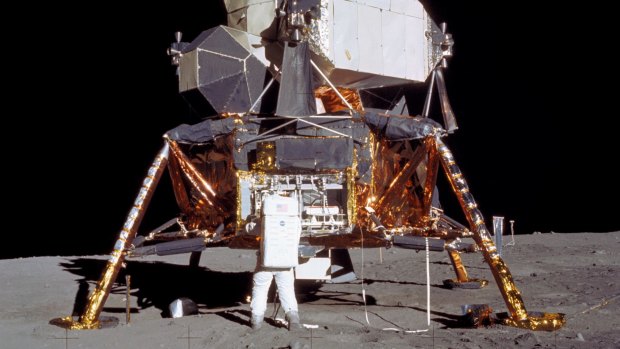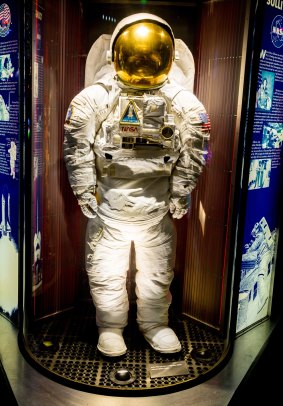This was published 6 years ago
Space Centre Houston marks the 50th anniversary of the moon landing
By Kerry van der Jagt

Buzz Aldrin and the Lunar Module on the moon.Credit: NASA
"Houston, Tranquility Base here. The Eagle has landed." These were Neil Armstrong's words relayed to NASA's Mission Control in Houston after he successfully parked Apollo 11's four-legged lunar module on the moon.
It was July 20, 1969, when Armstrong took that one small step, a step so marvellous that 600 million people tuned to watch. My memories of that winter's day* come from a black and white television in my Grade 2 classroom; blurry pictures and crackly voices, shadows and light, and a ghostly figure silhouetted against a black sky. In the mysterious way of childhood I'm not sure if these are actual memories, or footage viewed later, but I know for certain my interest in science was sparked that day.
Fast-forward almost five decades (2019 will be the 50-year anniversary of the landing) and I'm at Space Centre Houston, standing in front of Apollo 11's original Command Module Columbia, a rust-coloured capsule complete with scorch marks from where it re-entered the earth's atmosphere. My first thought – where the heck have the last 49 years gone?

One of the space suits at Houston Space Centre.
To commemorate the landing a travelling exhibition – Destination Moon: The Apollo 11 Mission – brings the Apollo 11 command module to Space Centre Houston from its home at the Smithsonian Institute in Washington.
Alongside the command module (the only portion of the Saturn V Rocket to return to Earth) the exhibition contains rare artifacts including Buzz Aldrin's visor and gloves, Michael Collins' Omega watch, star chart and survival kit. On display until March 18, 2018, the exhibition will travel to Saint Louis, Pittsburgh and Seattle before returning to Washington in 2020.
Space Centre Houston is also home to the command module from Apollo 17, the last mission to land men on the moon in 1972. "This means only in Houston and only for a short time can visitors see command modules from both the first and last lunar landings together," says my guide, Edward Ellingson.
From here I gravitate to Astronaut Gallery with its collection of space suits, marvel at specks of moon dust still clinging to the suit that Pete Conrad wore during Apollo 12, touch a piece of 3.8 billion-year-old moon rock and learn about NASA's Journey to Mars program (by current estimates humans will be orbiting Mars by the early 2030s).
While the museum provides many answers, it is also makes you question – Is space exploration worth the cost? What are the everyday benefits (beyond freeze-dried food and cordless drills)? Will it save humanity (against asteroids, climate change) and finally, why are humans driven to explore?
Everything inside the museum builds to the main event – a trolley tour that takes guests behind the scenes and onto the working grounds of the NASA Johnson Space Centre (included with general admission ticket).
Entering historic Mission Control, where NASA monitored nine Gemini and all Apollo missions, is as good as it gets for this space cadet. "It took 10 people to operate just one IBM 360 computer," says our guide, whose name happens to be Neil. "Today you could probably launch every rocket ever made using one app on your smartphone."
From the past I am rocketed to the future inside Building 9 where cutting edge research is paving the way for future exploration. Walking across an overhead platform we see where astronauts practice everything from living on the International Space Station to experimenting with crops for that long journey to the red planet.
On a tour of the grounds we pass a grove of memorial oak trees, most planted in honour of NASA astronauts who made the ultimate sacrifice – from the three-man crew of Apollo 1 to the seven-person crew of the space shuttle Challenger.
Watching deer graze beneath the trees I wonder, why are we hard-wired to challenge our earthly boundaries? Perhaps Buzz Aldrin's words, radioed to the world almost 50 years ago, are just as relevant today: "We feel that this stands as a symbol of the insatiable curiosity of all mankind to explore the unknown."
*It was 12.56pm on July 21, 1969 (Australian Eastern Standard Time)
TRIP NOTES
MORE
TRAVEL
United Airlines flies daily from Sydney and Melbourne to Los Angeles and non-stop from Sydney to Houston. See www.unitedairlines.com
Amtrak's Sunset Limited train connects Los Angeles with New Orleans, stopping at numerous cities including Houston; a superliner roomette costs from $402 per person. See www.railplus.com.au or call 1300 555 003
VISIT
Space Centre Houston is open daily (times vary seasonally). General admission tickets costs US$29.95 for adults and US$24.95 for children. See spacecenter.org
Kerry van der Jagt travelled as a guest of United Airlines, Railplus and Visit Houston
Sign up for the Traveller Deals newsletter
Get exclusive travel deals delivered straight to your inbox. Sign up now.